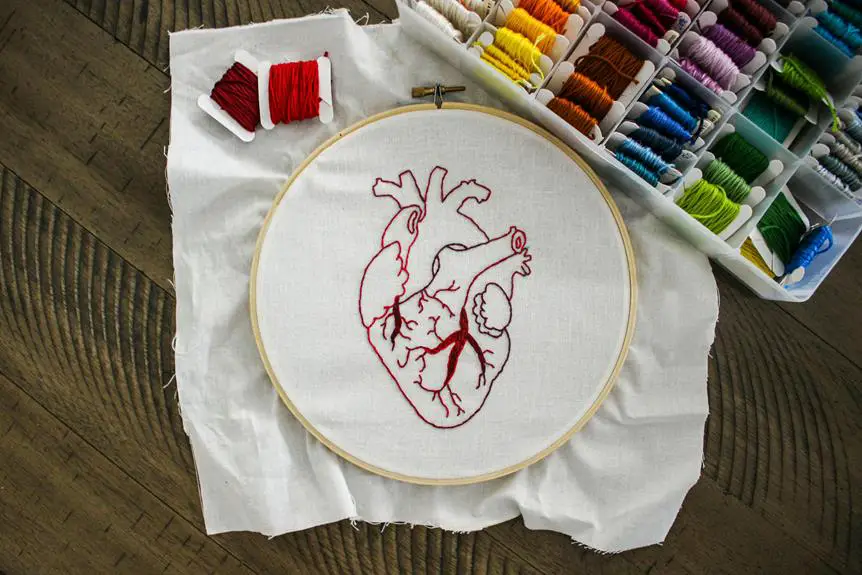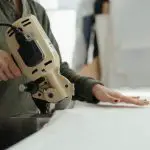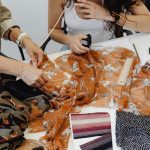When you think about cutting fabric for your craft projects, it's easy to stick with the basics, but there are so many creative ways to elevate your technique. You might explore specialty cutting tools that promise precision or experiment with different fabric patterns that could inspire unique designs. Using templates can streamline your workflow, while layering techniques can add depth to your creations. But what if you could turn leftover scraps into something truly remarkable? You'll want to consider how these methods can transform your projects in unexpected ways.
Table of Contents
Key Takeaways
- Utilize rotary cutters for quick, precise cuts, especially when working with multiple fabric layers for efficient crafting.
- Experiment with fabric shears to achieve clean edges and prevent fraying in intricate designs.
- Incorporate specialty knives for detailed cuts, particularly around curves and complex shapes.
- Use cutting mats to protect surfaces and enhance accuracy during the cutting process.
Using Specialty Cutting Tools
When you want to achieve clean edges and intricate designs, using specialty cutting tools can make all the difference. Instead of relying solely on standard scissors, consider investing in rotary cutters, fabric shears, and specialty knives. Each tool serves a unique purpose that enhances your fabric cutting experience.
Rotary cutters are perfect for straight lines and can slice through multiple layers of fabric with ease. They're especially useful for quilting projects where precision is key.
Fabric shears, designed specifically for cutting fabric, help prevent fraying and ensure smooth edges. Their ergonomic design makes them comfortable to use for extended periods.
Don't overlook specialty knives, like the craft knife, when you need to create detailed patterns or shapes. These tools allow you to make precise cuts around curves and corners that regular scissors might struggle with.
Using a cutting mat alongside these tools protects your work surface and extends the life of your blades. By choosing the right specialty cutting tools, you'll elevate your fabric projects, making every cut count and achieving professional-looking results every time.
Experimenting With Fabric Patterns
Using the right cutting tools opens up a world of possibilities for experimenting with fabric patterns that can transform your projects. When you take the time to play around with different techniques, you'll discover unique designs that can elevate your crafts.
Here are some strategies to get you started:
- Layering fabrics: Combine different patterns and colors to create depth and interest in your designs.
- Cutting shapes: Experiment with various shapes like circles, triangles, or abstract forms to add a playful element to your work.
- Using negative space: Leave gaps in your patterns to create visual intrigue and highlight the fabric's colors and textures.
Incorporating Cutting Templates
Incorporating cutting templates can streamline your fabric projects, ensuring precision and consistency in your designs. Whether you're working with intricate shapes or straightforward patterns, templates help eliminate guesswork, allowing you to focus on creativity. You can easily create your own templates by drawing shapes on sturdy cardstock or using existing patterns available online.
When you use templates, you save time by cutting multiple pieces at once. Simply lay your template on the fabric, secure it with pins or weights, and cut around the edges. This method not only maintains accuracy but also minimizes fabric waste. Plus, if you plan to replicate a project, having a template means you can easily recreate the design without measuring each time.
To enhance your templates, consider labeling them for future use. You can write down fabric types, project dates, or any adjustments you made. This way, you'll have a handy reference for your next project.
Exploring Different Cutting Techniques
When it comes to cutting fabrics, you've got options that can make a big difference in your projects.
You might choose between traditional scissors and rotary cutters, each offering unique benefits.
Plus, using fabric cutting mats can enhance your precision and protect your surfaces, so let's explore these techniques further.
Scissors Vs. Rotary Cutters
Choosing between scissors and rotary cutters can significantly impact your fabric cutting experience and the precision of your projects. Each tool offers distinct advantages, and understanding these can help you select the right one for your needs.
Scissors are great for:
- Versatility: They can cut a variety of materials, not just fabric.
- Control: You can easily maneuver them around intricate patterns.
- Portability: Lightweight and easy to carry, perfect for crafting on the go.
On the other hand, rotary cutters excel in:
- Speed: They cut through multiple layers of fabric quickly.
- Precision: The blade glides smoothly, resulting in clean edges.
- Less Strain: They reduce wrist fatigue during long cutting sessions.
Ultimately, your choice depends on your project's specific requirements. If you prioritize speed and precision, a rotary cutter might be the way to go.
But if you need versatility and control, scissors could be your best bet. Experiment with both to find what works best for you!
Using Fabric Cutting Mats
Fabric cutting mats provide a stable and protective surface that enhances your cutting techniques and extends the life of your tools. When you work on a mat, you avoid damaging your work surface, and the mat itself often has grid lines that help you align your fabric accurately.
Using a rotary cutter on a cutting mat allows for smooth, precise cuts, especially for straight lines. You can place your fabric over the grid lines to ensure everything's straight before you start cutting. If you prefer scissors, the mat still helps by providing a cushioned surface that prevents your scissors from dulling quickly.
To explore different cutting techniques, try layering multiple fabric pieces on your mat. This method is great for producing multiple shapes or patterns at once, saving you time. You can also use templates or rulers to trace designs before cutting, ensuring accuracy.
Experiment with various weights and types of fabric, as some may require different cutting techniques. Whether you're creating quilts, clothing, or home décor, a cutting mat is an essential tool that will elevate your craft projects.
Creative Layering Methods
When you're layering fabrics, understanding different techniques can elevate your projects.
You can play with textures, patterns, and color combinations to create stunning visual effects.
Let's explore how these elements work together to enhance your fabric cutting and crafting experience.
Layering Techniques Explained
Mastering layering techniques can elevate your sewing projects, adding depth and texture to your creations. When you layer fabrics, you create visual interest and enhance the overall aesthetic of your work. Here are some creative layering methods to explore:
- Fabric Selection: Choose materials with varying weights and textures. Mixing lightweight and heavy fabrics can create intriguing contrasts.
- Color Play: Use colors that complement each other. Layering different hues can bring about a vibrant or harmonious look, depending on your choice.
- Cutting Shapes: Experiment with various shapes and sizes. Layering cutouts or asymmetrical pieces can add a unique dimension to your projects.
Textures and Patterns
Exploring textures and patterns in your layering can transform a simple design into a stunning visual masterpiece. By combining different materials, you can create depth and intrigue in your craft projects. Start by selecting fabrics with contrasting textures, such as smooth silks paired with rough burlap or soft cotton with coarse linen. These contrasts engage the senses and invite viewers to explore your creation.
To enhance your layering, think about how patterns interact. Mixing stripes with florals or geometric designs with abstract prints can add vibrancy. However, balance is key—ensure that one pattern doesn't overpower the others.
Here's a quick reference table to help you choose your fabric combinations effectively:
| Texture | Pattern | Effect |
|---|---|---|
| Smooth Silk | Floral | Soft and romantic |
| Coarse Burlap | Stripes | Rustic and modern |
| Soft Cotton | Geometric | Fresh and clean |
| Textured Velvet | Abstract | Luxurious and dynamic |
Experiment with these suggestions, and you'll discover that layering textures and patterns will elevate your projects to new heights.
Color Combinations Ideas
To create visually striking designs, you can experiment with bold color combinations that enhance your fabric layering. The right mix of colors not only adds depth but also draws attention to your projects.
Here are some effective ideas to inspire your layering techniques:
- Complementary Colors: Pair colors opposite each other on the color wheel, like blue and orange, for a vibrant contrast.
- Analogous Colors: Use colors next to each other, such as yellow, orange, and red, to achieve a harmonious and calming effect.
- Triadic Combinations: Choose three colors that are evenly spaced on the color wheel, like red, yellow, and blue, to create a balanced and dynamic look.
When layering fabrics, consider how these combinations interact with textures and patterns. Experiment with different placements and proportions to find a unique balance.
Ultimately, don't be afraid to think outside the box; your creativity is the limit!
Upcycling Fabric Scraps
Upcycling fabric scraps not only reduces waste but also sparks creativity in your sewing projects. When you've got leftover pieces, think about how you can turn them into something new and functional. For instance, you can create patchwork quilts or stylish tote bags using a mix of different scraps. This not only gives your projects a unique flair but also maximizes the use of every bit of fabric.
Another great idea is to make fabric coasters or pot holders. Simply sew together small squares of fabric, and you'll have practical items that add personality to your home. You could also consider making fabric flowers or embellishments for clothing or accessories. These little touches can transform simple items into statement pieces.
If you're feeling adventurous, try your hand at creating a fabric collage or wall art using scraps. It's a fun way to express yourself and decorate your space without spending much. Don't forget about smaller scraps; they can be used for embellishing cards or gift tags.
Upcycling fabric scraps can lead to endless possibilities, so let your imagination run wild!
Frequently Asked Questions
What Types of Fabrics Are Best for Beginner Crafters?
When starting out, you'll find cotton, felt, and fleece are great choices. They're easy to handle, forgiving, and come in various colors. Choose fabrics that inspire you, and you'll enjoy your crafting journey even more.
How Do I Prevent Fraying When Cutting Fabrics?
To prevent fraying when cutting fabrics, you can use pinking shears, apply a fabric sealant, or zigzag stitch the edges. These methods keep your fabric neat and ensure your project looks polished and professional.
Can I Use Regular Scissors for Cutting Thicker Fabrics?
You can use regular scissors for cutting thicker fabrics, but it's better to choose fabric scissors for cleaner, smoother cuts. Regular scissors might struggle, causing uneven edges and making your project look less professional.
What Safety Measures Should I Take When Using Cutting Tools?
When using cutting tools, you should always wear safety goggles to protect your eyes, keep your fingers clear of blades, and ensure your workspace is clutter-free. Also, use tools designed for the material you're cutting.
How Do I Choose the Right Cutting Mat for My Projects?
When choosing a cutting mat, consider your project's size and the blade type. Opt for a self-healing mat for durability, and ensure it's thick enough to protect your workspace from cuts and damage.
- Tetron Fabric for Marine Applications: Durability and Use Cases - June 18, 2025
- Tetron Fabric for Outdoor Furniture: Weather Resistance and Care - June 18, 2025
- Tetron Fabric for Wall Coverings: Style and Application Tips - June 18, 2025







